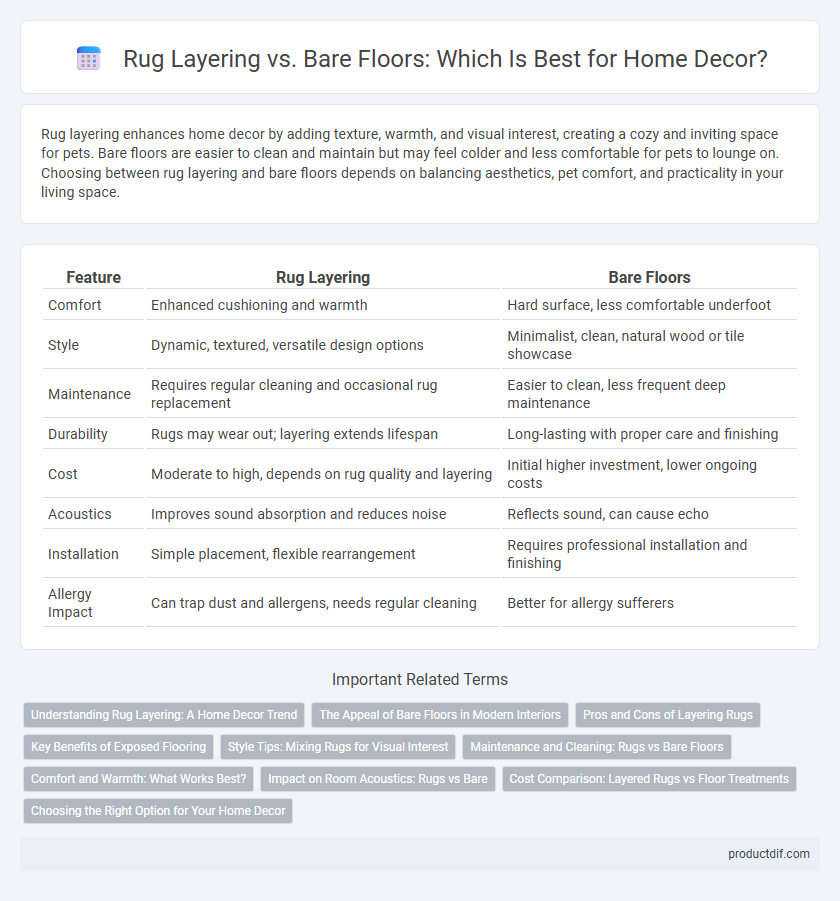Rug layering enhances home decor by adding texture, warmth, and visual interest, creating a cozy and inviting space for pets. Bare floors are easier to clean and maintain but may feel colder and less comfortable for pets to lounge on. Choosing between rug layering and bare floors depends on balancing aesthetics, pet comfort, and practicality in your living space.
Table of Comparison
| Feature | Rug Layering | Bare Floors |
|---|---|---|
| Comfort | Enhanced cushioning and warmth | Hard surface, less comfortable underfoot |
| Style | Dynamic, textured, versatile design options | Minimalist, clean, natural wood or tile showcase |
| Maintenance | Requires regular cleaning and occasional rug replacement | Easier to clean, less frequent deep maintenance |
| Durability | Rugs may wear out; layering extends lifespan | Long-lasting with proper care and finishing |
| Cost | Moderate to high, depends on rug quality and layering | Initial higher investment, lower ongoing costs |
| Acoustics | Improves sound absorption and reduces noise | Reflects sound, can cause echo |
| Installation | Simple placement, flexible rearrangement | Requires professional installation and finishing |
| Allergy Impact | Can trap dust and allergens, needs regular cleaning | Better for allergy sufferers |
Understanding Rug Layering: A Home Decor Trend
Rug layering enhances home decor by combining different textures, patterns, and sizes to create depth and visual interest in a space. This trend allows homeowners to customize comfort and style, making rooms cozier and more dynamic compared to bare floors. Popular layering strategies include pairing a large neutral rug with smaller, vibrant accent rugs to define areas and add warmth to living rooms and bedrooms.
The Appeal of Bare Floors in Modern Interiors
Bare floors emphasize clean lines and simplicity, enhancing the spaciousness of modern interiors while showcasing natural materials like hardwood or polished concrete. The minimalist aesthetic of uncovered flooring allows textures and colors to stand out without distraction, creating a sleek, airy atmosphere. This approach also simplifies maintenance and offers versatility in styling, making bare floors a favored choice in contemporary home decor.
Pros and Cons of Layering Rugs
Rug layering enhances texture and depth in home decor, offering a dynamic visual appeal and added warmth compared to bare floors. It allows for versatile design customization, combining patterns and colors to create a cozy, personalized atmosphere. However, layering rugs may require more maintenance, such as regular cleaning and ensuring secure placement to prevent slipping or uneven surfaces.
Key Benefits of Exposed Flooring
Exposed flooring enhances the natural beauty and texture of hardwood, tile, or stone, providing a sleek and spacious feel to any room. It simplifies cleaning and maintenance, reducing allergens and prolonging floor life by minimizing wear under rugs. This design choice also allows greater flexibility in room aesthetics, letting furniture and architectural features stand out without visual obstruction.
Style Tips: Mixing Rugs for Visual Interest
Mixing rugs through layering adds texture and depth, creating a dynamic focal point in any room, while bare floors promote a sleek, minimalist vibe. When layering, choose rugs with varying patterns, sizes, and materials to enhance visual interest and complement your existing decor. Opt for a neutral base rug topped with a smaller, bold-patterned piece to balance contrast and cohesion in your design.
Maintenance and Cleaning: Rugs vs Bare Floors
Rug layering offers added protection to floors by trapping dust and debris, making vacuuming more efficient, while bare floors require regular sweeping and mopping to prevent dirt buildup and scratches. Rugs need periodic deep cleaning and spot treatments to maintain their appearance and hygiene, whereas bare floors benefit from simpler maintenance routines using appropriate cleaners for wood, tile, or laminate surfaces. Choosing between rug layering and bare floors depends on lifestyle factors such as allergy sensitivity and cleaning preferences.
Comfort and Warmth: What Works Best?
Rug layering enhances comfort and warmth by adding multiple soft surfaces that insulate floors and retain heat, making spaces cozier compared to bare floors. Natural fibers like wool provide superior thermal insulation, while layered rugs add texture and depth, effectively trapping warmth. Bare floors, though sleek and easy to clean, often feel cold and less inviting without supplementary textiles.
Impact on Room Acoustics: Rugs vs Bare
Rug layering significantly enhances room acoustics by absorbing sound, reducing echo, and minimizing noise transmission compared to bare floors. Multiple rugs with varied textures create complex sound barriers that improve acoustic comfort in living spaces. Bare floors reflect sound waves, often resulting in louder, more reverberant environments that can disrupt peaceful ambiance.
Cost Comparison: Layered Rugs vs Floor Treatments
Layered rugs typically incur higher upfront costs due to purchasing multiple pieces, but they offer more flexibility and style variety compared to investing in expensive floor treatments like hardwood refinishing or tile installation. Over time, rugs can be replaced or updated at a lower cost than major floor renovations, making layered rugs a budget-friendly option for frequent design changes. Bare floors require less maintenance expense but often involve significant initial investment and potential refinishing costs to maintain their appearance.
Choosing the Right Option for Your Home Decor
Rug layering enhances texture and warmth, making spaces feel cozier while allowing for versatile design combinations, especially in living rooms and bedrooms. Bare floors showcase natural materials like hardwood or tile, emphasizing minimalism and easy maintenance ideal for high-traffic areas or modern interiors. Selecting between rug layering and bare floors depends on your lifestyle needs, room function, and the desired aesthetic impact within your home decor.
Rug Layering vs Bare Floors Infographic

 productdif.com
productdif.com